By James Darst
https://www.browning.com/products/catalog/firearms/detail.asp?fid=029B&cid=011&tid=801#center
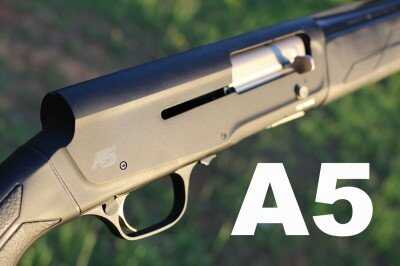 With the rising popularity of hunting and multi-gun competitions, shooters are looking for anything that can give them an edge. When it comes to the shotgun, keeping the weapon fed while negotiating complex courses of fire—speed of loading—is often decisive. Surprisingly, while you almost never see one used in competition, John Moses Browning’s Auto 5 shotgun may be one of the fastest loading semi-automatic shotguns of all time. Now Browning has reintroduced the A5. From the outward appearance, it looks as though they started making it the old Humpback again, but this couldn’t be further from the truth. While the new A5 is a faithful homage to the original John Browning design, the actual function has completely changed.
With the rising popularity of hunting and multi-gun competitions, shooters are looking for anything that can give them an edge. When it comes to the shotgun, keeping the weapon fed while negotiating complex courses of fire—speed of loading—is often decisive. Surprisingly, while you almost never see one used in competition, John Moses Browning’s Auto 5 shotgun may be one of the fastest loading semi-automatic shotguns of all time. Now Browning has reintroduced the A5. From the outward appearance, it looks as though they started making it the old Humpback again, but this couldn’t be further from the truth. While the new A5 is a faithful homage to the original John Browning design, the actual function has completely changed.
Just to be clear about nomenclature; Browning calls its new shotgun the A5. I’m going to refer to the old models (collectively, regardless of maker) as the Auto 5. If you want some more information on the history of this storied shotgun, check out Sam Trisler’s piece on the old-school humpbacks.
Browning’s new A5 line comes in a variety of configurations and patterns. This one is the A5 Stalker. It is a flat-black auto-loading homage to the old Auto 5, The Humpback, with some important modernizations. This one has a 26-inch barrel. The frame itself is a lightweight aluminum alloy. The stock is finished with Browning’s Dura Touch coating, which gives the gun a velvety feel. The A5 ships with two extensions that allow each shooter to customize the length of pull and shims for adjusting drop and cast. The gun ships in a compact, hard-sided case that makes transporting the gun easy and keeps everything, even the A5’s three Invector-DS choke tubes, organized. Empty, this Stalker weighs in at 7.5 pounds. The trigger breaks at 5.5 pounds.
The stock on the A5 Stalker is meant for hard use. While the Dura Touch finish offers a nice protective layer, and one that has a warmer feel than most bare polymers, the Stalker can take the abuse. The polymer stocks on these new guns will clearly separate them from the old Auto 5. Though the 20th century was defined by wooden-stocked sporting shotguns, wood is prone to swell and crack. It can be an issue, even in a gun safe. If you’re keeping the moisture level low to prevent rust, the wood on your stock is shrinking and can crack. Polymer may not have the same nostalgic look, but it is much easier to maintain. The only caution Browning offers for care of the Dura Touch finish has to do with the use of solvents and insect repellents that contain Deet. So pay attention to your choice of bug spray.
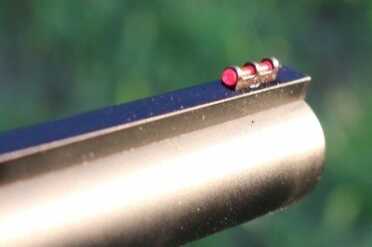
The front sight on the A5 is a bright red fiber optic. It sits on top of a long flat rail that extends all the way to the back of the receiver.
The sights on the Stalker are nice. The front sight is a red fiber optic sight that’s easy to see in low light conditions. Up the ventilated rib from that is a white bead. The white bead and the red front sight are useful for tracking sight alignment, especially when sweeping the barrel from side to side. If you see space between the red and the white, you may not be as on-target as you’d think. The rear sight is a lined groove that runs the length of the receiver, parallel to the bore. The rib is also grooved, and is flat black.
If you’re unfamiliar with the A5’s sight picture, there is a quick learning curve. Browning’s “humpback” design is less of a hump and more of a sharp drop. Where most shotgun receivers have a convex slope from the top of the receiver to the tang, the A5 simply drops off. The sight picture has more in common with most pistols than it does with most shotguns. When you raise the gun, the flat back end on the receiver acts like a big rear sight blade. Browning has branded this the Humpback Acquisition Advantage and argues that the design offers 30% more sight plane than traditional designs.

The hump of the Humpback makes the gun point naturally. Target acquisition happens quickly thanks to the channeled grooves.
While most of the gun’s features seem designed for utilitarian use, there are a couple of aesthetic touches that are recognizably Browning. The trigger guard has an engraved Buckmark buck mark. And the trigger is gold plated. They’re subtle touches common to Browning’s guns and unlikely to stand out enough to comprise camouflage.
The New Short Recoil Action
The original Auto 5 was built on a long-recoil action. The delay needed to allow chamber pressures to drop to safe levels before the action opened to eject the spent case was accomplished by leaving the bolt locked to the barrel as both traveled rearward under recoil until they both reached the rearmost travel of the bolt. At that point, the bolt unlocked from the barrel, allowing it to spring back to its original position. Once the barrel returned, the bolt was released, allowing it pick up a fresh round and chamber it, ready to fire again. Due to the different power levels of various shot shells, a friction ring located around the magazine tube slowed things down (for more powerful shells) or sped things up (for the lighter loads). But you had to change these rings in order for the gun to cycle different loads reliably, and that meant some disassembly.
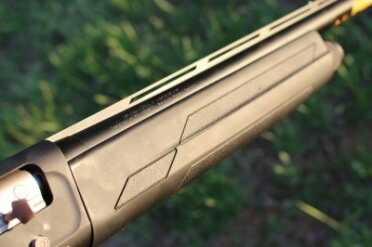
Because the A5 has no gas system, the forend can be trimmed down to a fairly thin profile (as thin as the mag tube will allow).
The new A5 is an inertia-recoil action that Browning calls Kinematic Drive. It now has a fixed barrel and a four-lug bolt and carrier assembly. When the round is fired, the resulting recoil drives the gun rearward, but the mass of the bolt carrier causes it to want to remain still as the rest of the gun moves around it. This compresses a fairly large spring located between the bolt and carrier. Once fully compressed, the spring forces the carrier back. This opens the bolt, ejecting the spent round and picking up a fresh one. Once the bolt returns to battery, the gun is ready to fire again.
The short-recoil Kinematic Drive System allows for the A5 to function with a wide power level of shells without the need to configure the friction rings of the earlier Auto 5. Now that the barrel is fixed, a barrel clamp can be added to an extended tube to better support it during recoil. In addition, Browning has lengthened the forcing cone. To top off the changes, Browning has slimmed down the forend, which is long enough to allow for any number of grip positions.

The Invector choke tubes have a brass ring around the base that helps seal the base of the tube in the barrel. Keeping the backside of the tubes clean makes removing them much easier.
Speed Load Plus
Aside from the action, what really differentiates the A5 shotguns, both old and new, from most other semi-auto shotguns currently manufactured is the speed of loading. This is enabled by the “unlocked” shell carrier. On the A5s, when the bolt locks to the rear on an empty chamber, the shell carrier will allow a shell to be fed into the loading gate without releasing the bolt. Once the shell is inserted into the tube, it doesn’t latch. Instead, the shell slips back out under the shell carrier, tripping a latch that closes the bolt while simultaneously chambering the round. With any shotgun that locks the carrier, a round must first be dropped into the chamber. The chamber then has to be closed, and then the tube can be loaded. With the A5, you simply start loading the magazine tube and one is chambered for you. Browning calls this “Speed Load Plus.” When the ducks and geese are coming in fast, a completely empty gun can be loaded without ever dropping the gun from your shoulder. You don’t have to turn the gun on its side, or wrap your left arm under in an elaborate speed-loading dance. Simply slam a shell into the tube and take that last shot at the turkey, or the target.
The Plus part of this is also a nice feature. Shells in the tube can be removed the same way they were put in, without having to cycle them through the chamber. Any rounds in the chamber can be pulled in the typical fashion, by pulling back on the bolt. The short Browning-produced video below illustrates both features.
The Speed Load Plus feature is one of the reasons the old A5s have such a solid fan base. The new A5 had to have to this feature. Without it, it wouldn’t be an A5. So how well does Speed Load Plus work on the new A5? The answer is complicated.

The small cut-out at the end of the gate isn’t quite wide enough for me to get my thumb out quickly, but a quick flicking motion still allows shells to be easily loaded.
When loading the new A5, we encountered a problem that the old A5 didn’t have. When inserting the round into the magazine, the shell lifter would drag on the case head. This drag stopped the shell from sliding back to release the bolt and load the round into the chamber. After playing with a few techniques to overcome this, I found that flicking the tip of my thumb off the round as it was loaded would work 100% of the time and the round loaded correctly. While it takes some getting used to, the motion becomes easier with time. We reached out to Browning and asked about the issue, and the response we got was puzzling. While it wasn’t meant to be more complicated on the new A5 than it was on the old Auto 5, it is, and it was designed that way. Everyone we talked to at Browning assured us that it just requires a bit of finesse, and that the motion is easy to master.
If it were my gun, one I’d use for competition, I’d shorten the lifter to allow for more time to drop as my thumb is moved out of the way. A slight angle cut on the non-ejection port side could also get the thumb out of the way for “dual load” and “quad load” techniques. The fix, if you want to call it that, is easy enough. Still, we were surprised to see that Speed Load Plus isn’t as fluid and foolproof on the A5 as it was on the gun’s predecessors.
Shooting the A5
The original Auto 5 design had one serious flaw. As I’ve already mentioned, you had to change out springs in order to handle varying recoil energies. The new A5 mitigates that. You can hammer geese with heavy 3-inch loads or pepper clays with 2.75 target loads. The gun will handle both. As the gun is designed for a variety of uses, it can handle anything in the 2.75- to-3 inch range. It won’t cycle the 2.75-inch rounds that are designed for exceptionally low recoil, but it comes close.
When it does cycle, the A5 is fast. Browning claims that the A5 is up to 10% faster than the actions of other (unnamed) competitors. While that rate of fire is hardly detectable to the naked eye (or ear), it could potentially influence the outcome of competitions. In the competitive world, where winning times can be decided by infinitesimally small margins, everyone is looking for anything that provides an edge. The A5 is one gun that many feel will give them that edge. The open-bolt loading can be a huge advantage in 3-gun. Of the guns used in 3-gun competition, the shotgun can make or break you. It holds the least ammo and is slowest to reload, and it is the first to run dry. Using the new “load two,” or the “quad-load” techniques, the reloads from an open bolt are superfast. When the gun goes empty, shells are inserted in line, two at a time, with the last one of the pair being chambered and the first latching into the magazine tube like normal.
Conclusions
The new A5 is a solid gun. Apart from the issue with the Speed Load learning curve, we didn’t have any issues. The balance is great. The weight is manageable. The new ability to cycle anything you feed it is a welcome change. And for those who like the modern loo, or want a dipped camo pattern on a synthetic stock, the A5 blends the old and the new in a most effective way.
That said, it isn’t the old Humpback Auto 5. It may look like the old Auto-5, but it isn’t. While the new design will always be compared to the old, the A5 deserves to be studied by itself. And after that, we plan on putting it up against some of the other auto-loading actions to see how the new heart of this A5 really stands up. When we know, we’ll bring you the update.
The MSRP on this A5 is $1,579. Browning is so confident in the new design that it is guaranteed it for 100,000 rounds or five years. I guess this should be your goal. Can you fire more than 100,000 rounds in five years? That’s 55 rounds a day, every day, for 1,825 days (which actually sounds like a half-assed practice schedule, when you break it down like that). Still. If only I had an ammo maker willing to help me find out ….
- The new A5s are available in a variety of finishes. This one is a nice flat black, but they come in dipped camo patterns or traditional wooden varieties.
- The A5 comes in a compact case for transporting the gun and all of its parts.
- The bolt on the A5 has four lugs. The Kinematic Drive system that drives the bolt makes this a fast auto-loading gun.
- The aluminum alloy receiver has some graceful lines. The finish is even and matches the Dura-Touch Armor Finish on the stock exactly.
- The flat back of the receiver is what gives it the Humpback nickname. It isn’t necessary for the new action, but Browning kept the design.
- A lightweight 12-gauge can kick like a mule. Even on the new A5, a good butt pad is a must.
- The texture on the stock and forend is less aggressive than I’d expected, yet the Dura-Touch finish gives even the smooth parts a tacky feel.
- It wouldn’t be a Browning without the Buckmark. This tiny accent on the trigger guard is a subtle touch of color on the otherwise black shotgun.
- One odd thing about the design is that the charging handle can be pulled out rather easily.
- The safety is easy to access with the trigger finger on the way to the trigger.
- The Invector DS Flush choke tubes are easy to screw in and out.


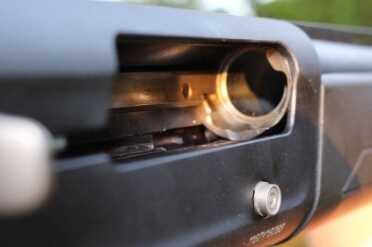



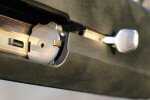

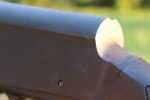

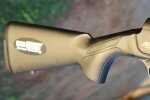
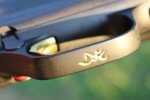
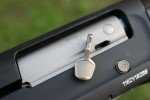
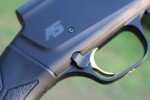
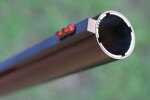
A few years back I owned an Auto 5 , 16ga. It was the older style with round knob,front to back safety,etc. I was at the farm in N.H. on the back screened porch and decided to slip another round in the magazine , like the gentleman above is doing .That darn thing went off and to this day no one can explain why. I suspect when modified to take 3 in. shells, something changed ?
Kind of ruined the Auto 5 experience for me . Could have been worse ,thank god no one was around that day !
I bought the new A5 in February and shot it twice and the trigger mechanism locked up both times. I’ve sent it in for the second time to be repaired…they’ve owed it longer than I have. If you ask me, it is by far the worst gun I’ve shot…and I owe 3 other Browning shotguns. Which will be my last. The A5 is a POS.
My grandfather, my father , myself and my children all used the original A5 humpback. My grandchildren will also. Contrary to this madness about synthetic stocks the fine wooden ones held up fine. Proof would be found in my 1939 A5 which is in its 3rd generation of use. it is the middle aged one of three I have. Same stock as original, same metal and shoots just fine. The beautiful browning blue has turned gay/blue but I would not trade it.
I quit using Browning products due to their current service policies and arrogant attitude. I should have added their parts policy. I doubt that other than persons profiting from sales or publicity of this weapon they have flagrantly violated the history of by calling it an A5 and the allegiance of the old weapon and their owners. Those that buy it by and large will not have fired the older weapon nor had any associated relation with it. I have many shotguns but none ae better or more loved than the A5.
When you can buy an original all forged steel A5 with a beautiful wood stock at any gun show for around 500 bucks who would be stupid enough to pay 1600 dollars for a modern cheapened aluminum framed gun with a junk plasticky stock. The “latest is not always the greatest” especially when it comes to brand new modern made crap.
funny everyone I know that has bought the new a5 has sent them back to browning for jamming, some have told browning they don’t want them back
As others have pointed out, where’s the mag extension? I guess I’m missing the competition angle to this gun because without the extension the other benefits (quicker cycling and easier loading) are rendered irrelevant.
A better question is at $1600 why ISN’T a magazine extension included.
You statement in Shooting the A5 that that the original Auto 5 design flaw is incorrect. You simply changed the location of a bushing relative to the friction ring to adapt to different shell loads. You never removed the recoil spring, except for cleaning.
IRCAA (Indian river county Airboat Association) has been raffling shotguns for many years. this is the second Browning A5 we have offered for the raffle. the response has been over whelming. This article will accompany the raffle shotgun because of the detail information you have supplied. Check out our web page and view the activities dedicated to conservation and youth.
I love my vintage Auto5. I also compete in multi-gun competition with a Mossberg 930. In the article you talk a lot about loading and competing with the A5 – until a factory or aftermarket extended mag is available the great sounding gun WILL be at a serious handicap. I’m surprised that was not addressed in the article?!
Does it have a magazine extension? If not- no 3 gun
Nordic Components and RCI both make tubes for it.